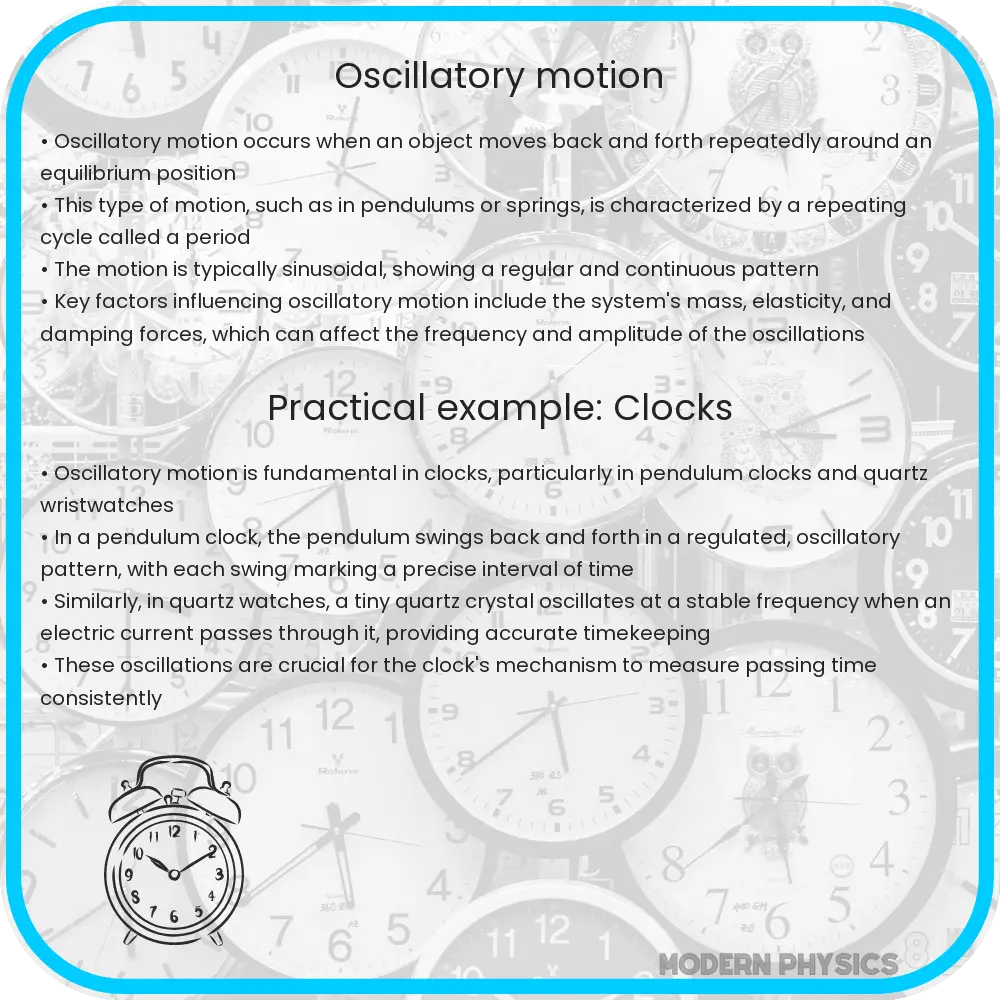Explore the fundamentals of oscillatory motion, covering harmonic, damped, and forced kinematics, and their applications in physics and engineering.

Oscillatory Motion: Understanding the Basics
Oscillatory motion, a fundamental concept in physics, refers to the repeated back and forth movement of a system about a central position or equilibrium point. This motion is a key element in various physical phenomena and technological applications. In this article, we will explore the three primary types of oscillatory motion: harmonic, damped, and forced kinematics.
Harmonic Motion
Harmonic motion is the simplest form of oscillatory motion, characterized by a restoring force proportional to the displacement from an equilibrium position. This motion is best exemplified by the classical example of a mass attached to a spring. The mathematical description of harmonic motion is given by Hooke’s Law, which states F = -kx, where F is the force, k is the spring constant, and x is the displacement from the equilibrium. The motion of such a system can be described by a sine or cosine function, representing periodic motion with a constant amplitude and period.
Damped Motion
Damped motion introduces the concept of energy dissipation in oscillatory systems. In the real world, no system can oscillate indefinitely due to frictional forces, air resistance, and other forms of energy loss. This type of motion is described by a decreasing amplitude over time. The equation governing damped motion is an extension of the simple harmonic motion equation, including a damping term proportional to the velocity: F = -kx – bv, where b is the damping coefficient, and v is the velocity.
Forced Motion
Forced motion occurs when an external periodic force is applied to an oscillating system. This external force can alter the natural frequency of the system, leading to phenomena like resonance. The equation for forced motion is similar to that of damped motion, with the addition of a driving force term: F = -kx – bv + F0sin(ωt), where F0 is the amplitude of the driving force, and ω is its angular frequency.
Each type of oscillatory motion has unique characteristics and equations governing its behavior. Understanding these motions is crucial for fields ranging from mechanical engineering to quantum mechanics.
Applications and Implications of Oscillatory Motion
Oscillatory motion is not just a theoretical concept; it has practical applications in various fields. In engineering, the principles of harmonic motion are utilized in the design of springs and shock absorbers. Understanding damped motion is crucial for designing buildings that can withstand earthquakes by dissipating vibrational energy effectively. Similarly, forced motion principles are employed in various technologies, from musical instruments, where resonance enhances sound, to advanced scientific equipment like particle accelerators.
Beyond mechanical systems, oscillatory concepts are vital in the study of electrical circuits. The behavior of inductors and capacitors in AC circuits can be analyzed using similar mathematical models as mechanical oscillators. In the realm of quantum mechanics, the concept of quantized energy levels in atoms resembles harmonic oscillators, playing a pivotal role in understanding atomic behavior and interactions.
Challenges and Future Perspectives
While the basic principles of oscillatory motion are well-understood, challenges remain in complex systems where non-linear dynamics come into play. For example, chaotic behavior in certain oscillatory systems, where small changes in initial conditions lead to vastly different outcomes, is an area of ongoing research. Advancements in computational power and algorithms are enabling more accurate simulations and predictions of such complex systems.
Furthermore, the exploration of oscillatory phenomena at extremely small (quantum) and large (cosmological) scales presents exciting opportunities for discovery. Understanding oscillatory motion at these scales could unlock new insights into the fundamental nature of matter and the universe.
Conclusion
In conclusion, oscillatory motion, encompassing harmonic, damped, and forced kinematics, is a cornerstone of physics with far-reaching implications across multiple disciplines. From the macroscopic to the microscopic, these motions provide a framework for understanding a vast array of natural phenomena and technological applications. As research continues, the depth and breadth of our understanding of oscillatory motion will undoubtedly expand, revealing new mysteries and solutions in the intricate tapestry of the physical world.
